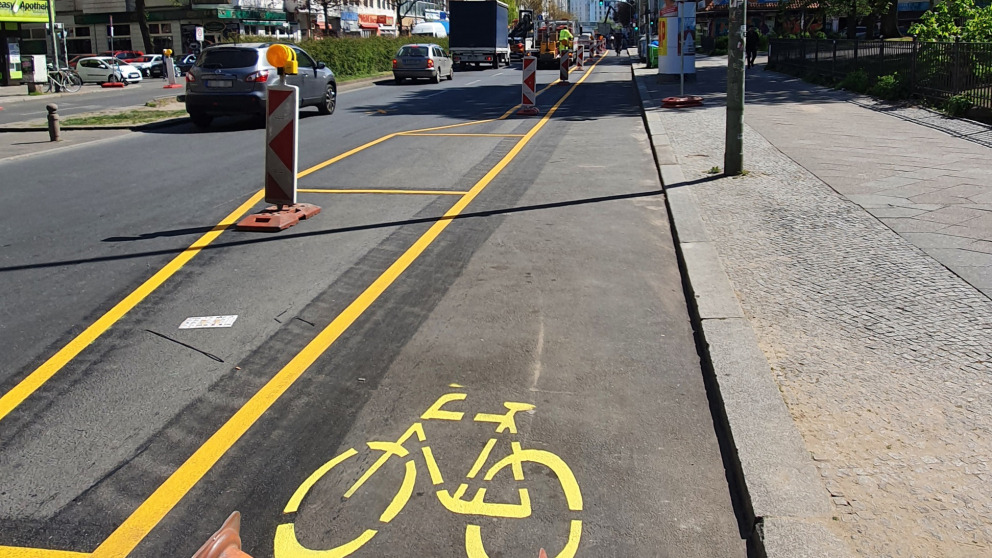A win-win for cyclists – measuring effects of the transport transition on air quality
24.08.2021

Recently, the team of the “Climate Change and Air Pollution” (ClimPol) project published an article in Environmental Research Letters detailing the results of a measurement campaign conducted along Kottbusser Damm in Berlin-Kreuzberg. In short, we found that the implementation of a protected pop-up bike-lane along the street reduced the amount of air pollution cyclists were exposed to by 22%. On its own this is a significant, but perhaps not unexpected result. However, to set these results in their proper context, first we need to rewind back to 2018.
Following the successful citizen-led petition on cycling in Berlin (Volksentscheid Fahrrad), the state government became the first in Germany to pass a Mobility Act, redefining how the city-state would approach transportation planning for decades to come. The Act focuses primarily on road safety and provision of infrastructure, in large part incorporating suggestions from the draft bicycle law put together by citizen groups, including core concepts such as “Vision Zero”, which aims to reduce deaths and serious injuries in traffic-related accidents to a minimum. While safety and cycling were key components of the Mobility Act, it also lays the foundations for an expansion of Berlin’s public transport systems, pedestrian space, and intelligent transportation, combining these with existing provisions for private cars and commercial transport.
With this context in mind, when we fast forward to 2020 and the implementation of the new bike lane on Kottbusser Damm, we see the direct impact of this legislation on its design. It is 2 meters wide, protected by bollards to prevent cars from parking in the way, and ensures that cyclists can safely and quickly traverse the length of the street. However, our campaign showed that this new infrastructure had positive effects on cyclists beyond their immediate safety. Now that they no longer had to ride among traffic, often inhaling direct tailpipe emissions when cycling along the busy street, cyclists were exposed to lower concentrations of nitrogen dioxide (NO2) than before.
To make sure this could not be attributed to associated local changes in air quality, we complemented our mobile bicycle measurements with stationary measurements along the street. Even after accounting for changes in air quality due to the pandemic-related lockdowns and meteorology, this research showed that cyclists were exposed to median NO2 concentrations 8.4 ± 7.4 µg/m³ lower while riding in the protected bike lane than in the road. These reductions were even higher at the 95th percentile (14 ± 7.4 µg/m³), highlighting the likely greater protection of cyclists from peak tailpipe emissions with the new infrastructure. In essence, the further away cyclists are away from diesel vehicles emitting NO2, the less exposed they are to the harmful effects of this pollution; hence, the not unexpected result.
What is key to note about this, however, is that a similar situation is playing out on many streets across Berlin where new protected bike lanes are being built. Kottbusser Damm is but one example of many planned measures across a changing cityscape. Not only are cyclists across Berlin becoming safer, but they are likely also becoming better protected from harmful air pollution. Moreover, the health benefits of active travel outweigh the negative effects of air pollution (see studies by Giallouros, G., et al. (2020) and Tainio, M., et al. (2021)), so it follows that a reduction in air pollution exposure while cycling improves the overall gains in physical health from active travel. Although not directly envisioned in the Mobility Act of 2018, it seems that changes to Berlin’s infrastructure have led to a win-win for cyclists, where they are becoming safer and healthier while cycling around the city. If the new infrastructure encourages greater uptake of cycling in Berlin, the health benefits of these measures will be felt on a city scale.
Of course, while these measures are great for cyclists, they are also taking away physical space from car traffic. Without large-scale policies that reduce the need for cars in Berlin, it is also possible that the air pollution cars produce will get relocated to other parts of the city, thereby shifting the burden of pollution to another portion of the population. While our research has highlighted clear benefits for cyclists, we emphasize the need for a coherent transport transition in Berlin and across Germany to ensure that these benefits are spread among all transportation users.
